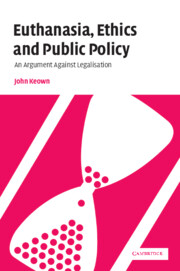Book contents
- Frontmatter
- Contents
- Preface
- Foreword
- Acknowledgments
- Table of cases
- List of abbreviations
- Introduction
- PART I Definitions
- PART II The ethical debate: human life, autonomy, legal hypocrisy, and the slippery slope
- PART III The Dutch experience: controlling VAE? condoning NVAE?
- PART IV Australia and the United States
- 14 The Northern Territory: ROTTI
- 15 Oregon: the Death with Dignity Act
- PART V Expert opinion
- PART VI Passive euthanasia: withholding/withdrawing treatment and tube-feeding with intent to kill
- Conclusions
- Afterword
- Bibliography
- Index
14 - The Northern Territory: ROTTI
Published online by Cambridge University Press: 20 July 2009
- Frontmatter
- Contents
- Preface
- Foreword
- Acknowledgments
- Table of cases
- List of abbreviations
- Introduction
- PART I Definitions
- PART II The ethical debate: human life, autonomy, legal hypocrisy, and the slippery slope
- PART III The Dutch experience: controlling VAE? condoning NVAE?
- PART IV Australia and the United States
- 14 The Northern Territory: ROTTI
- 15 Oregon: the Death with Dignity Act
- PART V Expert opinion
- PART VI Passive euthanasia: withholding/withdrawing treatment and tube-feeding with intent to kill
- Conclusions
- Afterword
- Bibliography
- Index
Summary
The Northern Territory (NT) is a vast but sparsely populated area in Australia, occupying a sixth of the continent but with a population of less than 200,000. In 1995, its legislature of twenty-five enacted (by a small majority) the Rights of the Terminally Ill Act (‘ROTTI’). The Act permitted both PAS and VAE.
ROTTI
ROTTI was a long and complex Act. This chapter will first outline its main provisions and then consider whether they were any more capable of preventing abuse than the Dutch guidelines.
The Act stated that it sought ‘to confirm the right of a terminally ill person to request assistance from a medically qualified person to voluntarily terminate his or her life in a humane manner; to allow for such assistance to be given in certain circumstances without legal impediment to the person rendering the assistance’ and ‘to provide procedural protection against the possibility of abuse of the rights recognised by this Act’.
The patient's request
Section 4 provided that a patient who ‘in the course of a terminal illness’ was experiencing ‘pain, suffering and/or distress to an extent unacceptable to the patient’ could ‘request the patient's medical practitioner to assist the patient to terminate the patient's life’. The Act defined ‘terminal illness’ as an illness which ‘in reasonable medical judgment will, in the normal course, without the application of extraordinary measures or of treatment unacceptable to the patient, result in the death of the patient’.
- Type
- Chapter
- Information
- Euthanasia, Ethics and Public PolicyAn Argument Against Legalisation, pp. 153 - 166Publisher: Cambridge University PressPrint publication year: 2002

